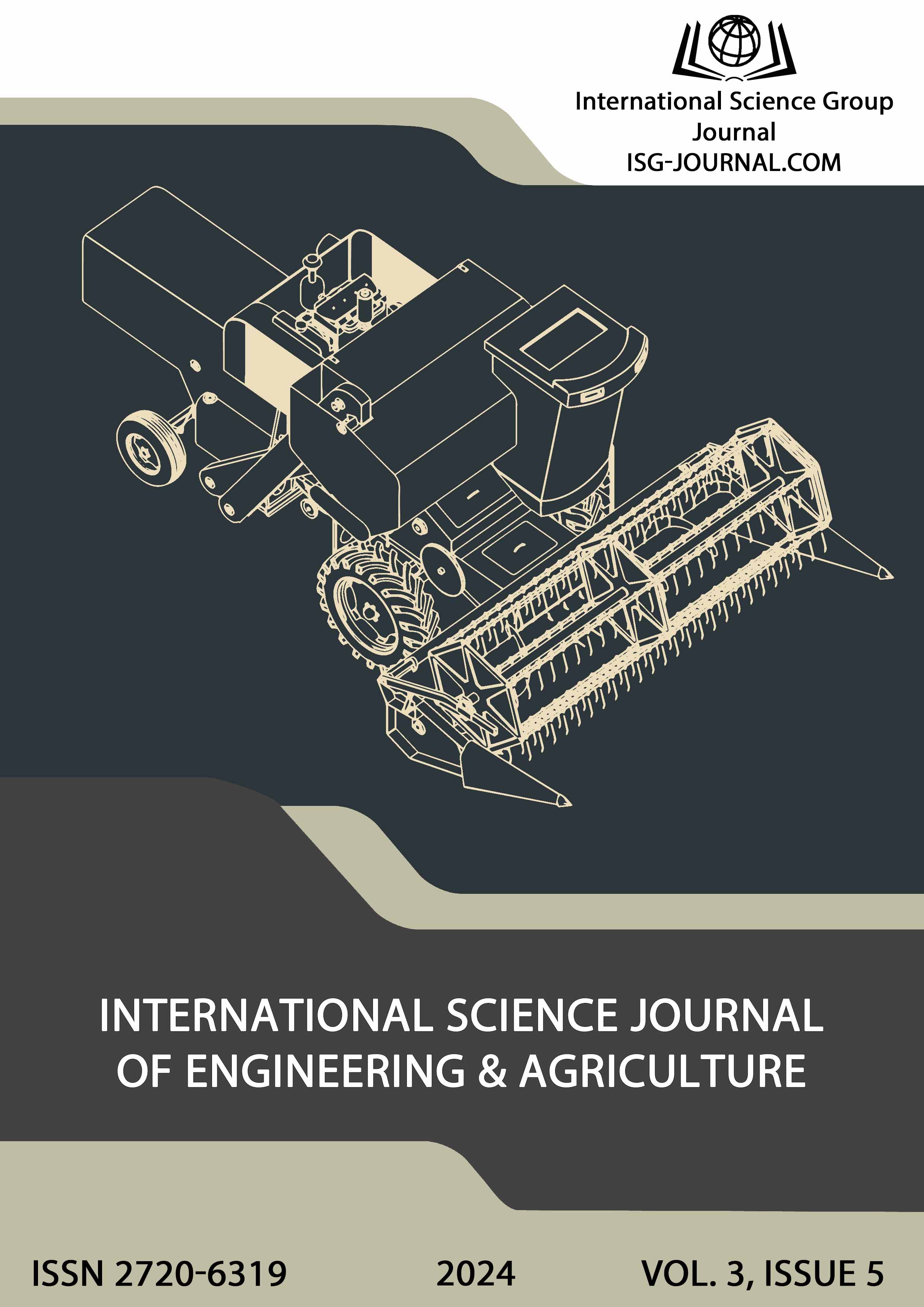Experimental determination of the heat transfer coefficient by a simplified method for the stationary heat exchange mode in the air cleaner
DOI:
https://doi.org/10.46299/j.isjea.20240305.03Keywords:
air cleaner, recuperative heat exchanger, recirculating air cleaner, heat exchange, heat transfer coefficientAbstract
The research is aimed at the development of an air cleaner with an additional air heating function. The study examines the heat exchange processes in the air-to-air heat exchanger of the outdoor air heating in the recirculation section of the air cleaning unit equipped with HEPA 11 filter inserts. The calculations are valid for recirculation type air cleaning units with cleaning performance in the recirculation part in the amount of 300 to 1000 m3/hour. The amount of air cleaned in the recirculation section of the air purifier allows you to heat a certain volume of air from the street, while the expected temperature of the air recirculating in the room will decrease by only two degrees, from the initial temperature of 20C to 18C. The regression equation describing the forecasting of the temperature of the cold heat carrier at the exit from the heat exchanger and the heat transfer coefficient of the heat exchanger was determined by the method of conducting a full factorial experiment. The adequacy of the regression equation was confirmed by statistical analysis. The effective volumetric flow rate of the cold heat carrier at the average real speed in the tubes along which the cold heat carrier moves and the temperature difference of the cold heat carrier at the entrance to the heat exchanger and at the exit from it are determined. Based on these values, the heat flow perceived by the cold coolant from the hot coolant is determined. The heat transfer coefficient was determined experimentally by a simplified method for the stationary mode of heat exchange. The study data confirmed the feasibility of using an air-to-air heat exchanger for heating the outside air in the recirculation section of the air cleaning unit (air cleaner) for heating the outside air without using additional energy. The air cleaner has a periodic nature of operation and is used as needed.References
Tong, D. Q., Gill, T. E., Sprigg, W. A., Van Pelt, R. S., Baklanov, A. A., Barker, B. M., ... & Vimic, A. V. (2023). Health and safety effects of airborne soil dust in the Americas and beyond. Reviews of Geophysics, 61(2), e2021RG000763. https://doi.org/10.1029/2021RG000763
GB 15982-2012. Hygienic standard for disinfection in hospitals. Beijing, China: General Administration of Quality Supervision, Inspection and Quarantine of the People’s Republic of China, 2012.
ANSI/ASHRAE/ASHE Standard 170-2017: Ventilation of Health Care Facilities. Atlanta, USA: American Society of Heating, Refrigeration and Air-Conditioning Engineers, 2017.
HTM 03-01: Specialised ventilation for healthcare premises: part A – design and validation. London: Department of Health/Estates and Facilities Division, 2007.
CEN/TS 16244:2018. Ventilation in hospitals – coherent hierarchic structure and common terms and definitions for a standard related to ventilation in hospitals. Brussels: Comite Europeen de Normalisation, 2018.
ДБН, В. (2022).2.2-10:2022 "Заклади охорони здоров’я ". Мінрегіон України, К.. Available at: https://dbn.co.ua/load/normativy/dbn/v_2_2_10/1-1-0-1805
Maung, T. Z., Bishop, J. E., Holt, E., Turner, A. M., & Pfrang, C. (2022). Indoor air pollution and the health of vulnerable groups: a systematic review focused on particulate matter (PM), volatile organic compounds (VOCs) and their effects on children and people with pre-existing lung disease. International journal of environmental research and public health, 19(14), 8752. https://doi.org/10.3390/ijerph19148752
Chen, J., & Hoek, G. (2020). Long-term exposure to PM and all-cause and cause-specific mortality: a systematic review and meta-analysis. Environment international, 143, 105974. https://doi.org/10.1016/j.envint.2020.105974
Tran, H. M., Tsai, F. J., Lee, Y. L., Chang, J. H., Chang, L. T., Chang, T. Y., ... & Chuang, H. C. (2023). The impact of air pollution on respiratory diseases in an era of climate change: A review of the current evidence. Science of the Total Environment, 166340. https://doi.org/10.1016/j.scitotenv.2023.166340
Макаренко, Л. І., & Приймак, О. В. (2023). Забезпечення рекомендованої ВООЗ якості повітря в офісних приміщеннях з існуючою системою вентиляції. Вентиляція, освітлення та теплогазопостачання, 44, 17-22.
Szczotko, M., Orych, I., Mąka, Ł., & Solecka, J. (2022). A review of selected types of indoor air purifiers in terms of microbial air contamination reduction. Atmosphere, 13(5), 800. https://doi.org/10.3390/atmos13050800
Dubey, S., Rohra, H., & Taneja, A. (2021). Assessing effectiveness of air purifiers (HEPA) for controlling indoor particulate pollution. Heliyon, 7(9). doi:10.1016/j.heliyon.2021.e07976
US Environmental Protection Agency. (2021). Air cleaners, HVAC filters, and coronavirus (COVID-19). Available at: https://www.epa.gov/coronavirus/air-cleaners-hvac-filters-and-coronavirus-covid-19
Harriman, L., Stephens, B., & Brennan, T. (2019). New guidance for residential air cleaners. ASHRAE J, 61, 14-23.
REHVA. Federation of European Heating, Ventelation and Air Conditioning Associations. Criteria for room air cleaners for particulate matter. Available at: https://www.rehva.eu/new-document-online-criteria-for-room-air-cleaners
Pagels, J., Alsved, M., Malmborg, V., Omelekhina, Y., Wierzbicka, A., & Bohgard, M. (2019). Airborne dust removal using mobile air cleaners in the construction sector. ISSN: 1650-3717.
ДБН, В. (2013). 2.5-67: 2013 Опалення, вентиляція та кондиціонування. Мінрегіон України, К.
Available at: https://e-construction.gov.ua/laws_detail/3074971619479783152?doc_type=2
Yang, Z., Zhao, J., Wang, B., Zhuang, R., Li, X., Xiao, H., & Shi, W. (2021). Experimental performance analysis of hybrid air conditioner in cooling season. Building and Environment, 204, 108160.
Sheng, Y., Fang, L., & Sun, Y. (2018). An experimental evaluation on air purification performance of Clean-Air Heat Pump (CAHP) air cleaner. Building and Environment, 127, 69-76.
O’Connor, D., Calautit, J. K., & Hughes, B. R. (2016). A novel design of a desiccant rotary wheel for passive ventilation applications. Applied Energy, 179, 99-109.
Alekseik, Y., & Alekseik, O. (2022). КОНСТРУКЦІЇ ТЕПЛООБМІННИХ АПАРАТІВ НА ДВОФАЗНИХ ТЕПЛОПЕРЕДАВАЛЬНИХ ЕЛЕМЕНТАХ ДЛЯ УТИЛІЗАЦІЇ ТЕПЛОТИ ПОВІТРЯ У ВЕНТИЛЯЦІЙНИХ СИСТЕМАХ: ОГЛЯД. KPI Science News, 135(1-2), 11-25.
Makarenko, L. (2024). Модель повітроочисника з фільтрувальними вставками НЕРА 11 та теплообмінником нагріву зовнішнього повітря в рециркуляційній секції. International Science Journal of Engineering & Agriculture, 3(2), 67-77.
Downloads
Published
How to Cite
Issue
Section
License
Copyright (c) 2024 Luibov Makarenko

This work is licensed under a Creative Commons Attribution 4.0 International License.






